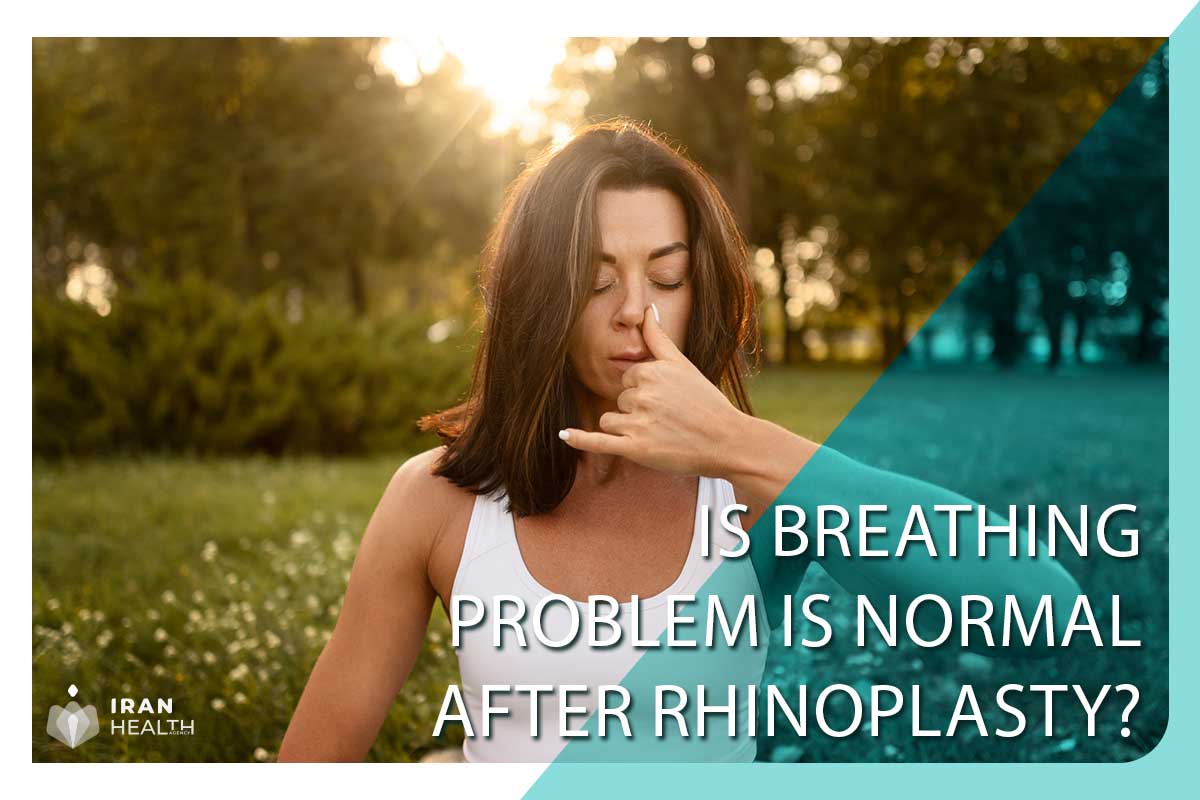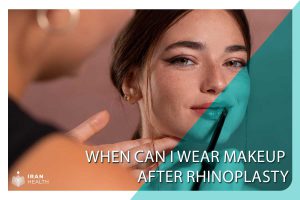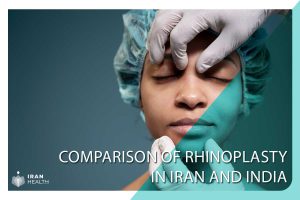If we want to explain what makes the face more beautiful, we can point out that the symmetry of the nose has a great effect on the beauty of the nose, but unfortunately in some patients after rhinoplasty they find that the two nostrils are not symmetrical. Keep in mind that immediately after surgery, your two nostrils may look asymmetrical and do not worry about it, but if your recovery period is over, the two nostrils should be symmetrical.
Many factors can cause asymmetry of the nostrils for a short time, one of which is swelling of the nose, which resolves over time after the swelling has improved.
In rhinoplasty in Iran, many variables must be considered to achieve a good and satisfactory result, so this surgery is one of the most challenging operations.
There are two valves on each side of the nose
Most patients after nose job worry that the nasal congestion is always with them and they can no longer breathe properly and always have problems. breathe with them, but this problem is not permanent and is due to swelling of the nose, which is usually very easy to correct
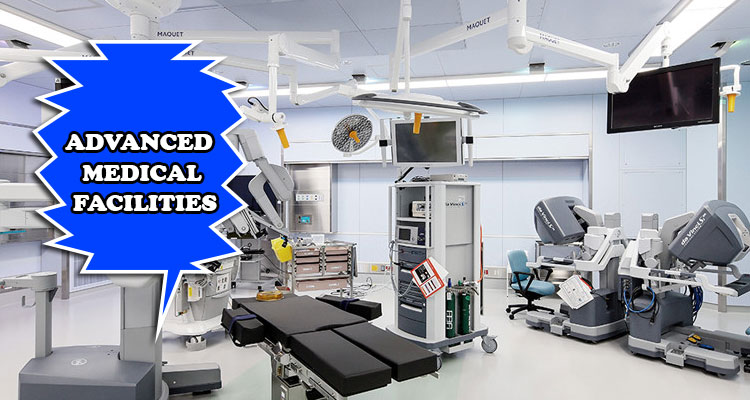
Solutions that can help you during this time:
Do not lower your head and always hold it (1 high, even when you are asleep.
1) Be sure to follow your doctor’s instructions for postoperative instructions
2) If you have allergies, try to avoid things that cause allergies in you, for example, pollen can be allergenic
Some physicians prescribe a diet or medication or special method for patients after surgery to have a positive effect on possible complications after surgery and to improve possible complications soon.
Once the swelling subsides, you should be able to breathe well. If you still can not breathe well after the swelling healed, be sure to see your surgeon and let him know your condition.
nose. Some people have trouble breathi after rhinoplasty due to narrowing of the nasal angle and compression of the nasal valves. According to some doctors, excessive removal of cartilage can cause the patient to have trouble breathing because it causes both sides of the nose to collapse.
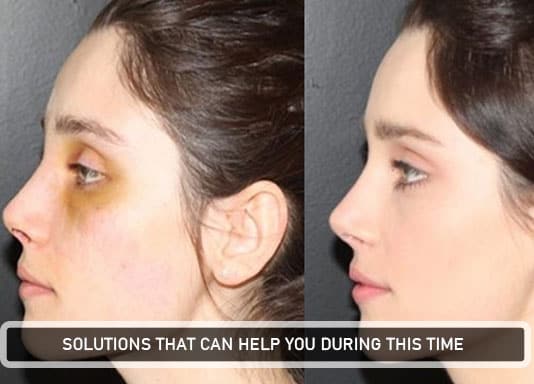
respiratory problems can be improved after rhinoplasty
Nowadays, with the advancement of science and progress in rhinoplasty, the methods of rhinoplasty have changed and made significant progress, so that rhinoplasty no longer focuses on cartilage for rhinoplasty and this surgery is performed more by changing the position of the nose.
But because science had not reached this point in the past and rhinoplasty had not progressed so far, a number of patients who had undergone surgery in the past came to the doctor with respiratory problems, but according to one doctor this problem could be fix. Fortunately, patients with respiratory problems need to see a doctor and have reoperation for areas that have been over-operated.
Study about Nose job Iranian style
Temporary congestion is common in the first few weeks, but if the congestion persists for a long time and the patient continues to block the nose, the patient will develop a long-term obstruction when the surgeon does not think about maintaining the structure of the nose Nasal airway
When you have rhinoplasty with a very skilled plastic surgeon, you will be more satisfied with the result and your surgical risks will probably be reduced, but only when the surgery is performed by a plastic surgeon. Those who are less skilled in this work, the result of surgery with them will not be great
In this surgery, the inner diameter of the nose becomes smaller than before.
If your breathing problem is similar to sinus congestion, wait a while after the operation to see if the problem goes away, because this problem occurs due to swelling of the nose after surgery, which is completely normal and there is no need to worry that in most cases this problem Disappears weeks after surgery.
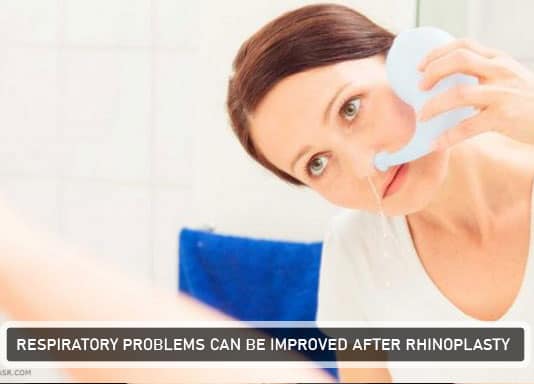
Discomforts you may usually experience after surgery:
1) You may have a sore throat after regaining consciousness because a breathing tube is inserted into the patient’s trachea during anesthesia.
2) Nausea
3) They have insomnia and restlessness.
4) Feel thirsty.
What are the risks of rhinoplasty?
Some of the risks after rhinoplasty are:
1) Anesthesia
2) Bleeding
3) Rupture of some small capillaries on the surface of the skin
4) scar effect
5) Swelling
6) The need for reoperation
7) Causing nerve damage without recovery and permanent
After surgery, your doctor will tell you what medications you should not take because some medications cause you to bleed more, so your doctor will stop you from taking them.
Do not prescribe medication without a doctor’s prescription. Smoking after surgery can negatively affect your recovery and prolong your recovery, and you may even be at risk of infection due to smoking.
The doctor will usually attach a splint to your nose to further protect it, which will stay in place for about a week. This is to further protect your nose.
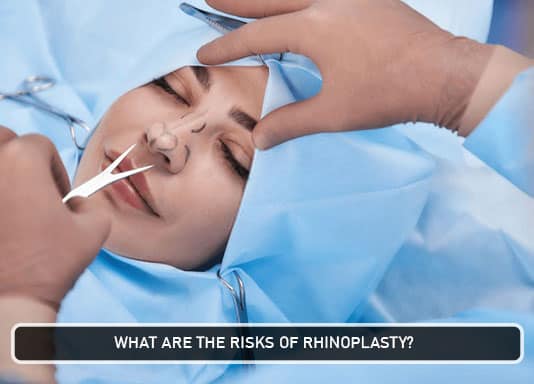
The most common cause of obstruction in people who have had rhinoplasty is nasal decay.
The nasal valve is farther from the center of the nose. If the internal nasal valve collapses after rhinoplasty, it is usually reoperated and an applicator is placed in the nose to open the nasal valve. A sign that the nasal valve may have collapsed is a bulge inside the nose.
These bumps are cartilage that is misplaced or weakened. This causes shortness of breath that the patient can not breathe easily and the patient has problems
In some patients, the wound may become infected after surgery due to the entry of bacteria into the wound, which can lead to infection at the wound site, which travels through the bloodstream to other parts and causes infection.
In some cases, patients may have lung problems due to the doctor not following the breathing exercises, but it can have other reasons such as inhaling blood or water or food in the airways or pneumonia.
Symptoms of this problem: wheezing, shortness of breath, pain, fever and cough Urinary retention This problem has also been reported in some patients after surgery.
Urinary retention means that the patient can not empty his bladder. The reason may be anesthesia or special surgery.
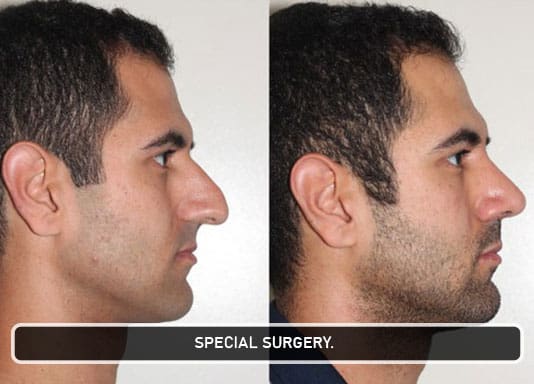
They often use a special tube to treat it until the patient can control his bladder again has different side effects in each person and it is possible that in one person there is no particular complication at all and in another person there are annoying complications that this is due to differences in the patient’s age and history and different surgical procedures.
Rhinoplasty should be performed under the supervision of an experienced specialist.
Rhinoplasty can be performed to change the shape of the nose:
Shrink the size of the nose Changing the angle of the upper lip with the nose Enlarge the nose If the result of your nose job is not to your liking or you are experiencing unexpected pain or your symptoms are unexpected, be sure to tell your doctor and talk to your doctor about your symptoms to find a suitable solution in this regard.
Some people have respiratory problems before surgery that they want to have with surgery. One of the reasons that cause respiratory problems can be septal deviation that the patient sees a doctor to solve this problem.
In some cases, the patient has a respiratory problem due to obstruction of the nasal passages and sees a doctor to fix it. Narrowing of the airways causes the patient to not get enough oxygen and to have symptoms such as dizziness, headache or lightheadedness.
In the cases described above, rhinoplasty is not only done to make the nose more beautiful and different, but also to treat the patient’s problems and ease his breathing.
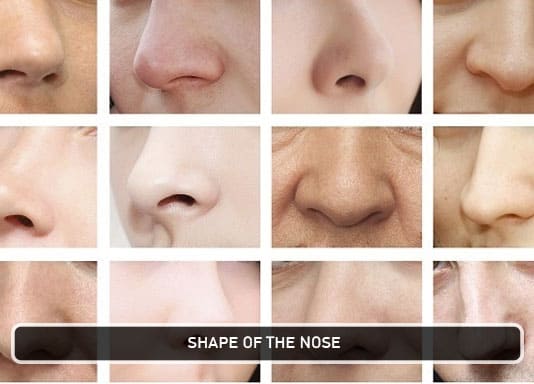
Rhinoplasty procedures
1) Closed septoplasty: This surgical procedure is used to smooth the bone and cartilage between the two nostrils.
2) Open septorhinoplasty: This operation is for correction in both the nose and the nasal septum.
3) Open nose surgery: The advantage of this method is that in this method, the structure of the nose can be more supported and more cartilage can be preserved.
4) Balloon sinuplasty
To treat chronic sinusitis, this method can be used, which does not require implantation or other additional methods, and the results of this method are permanent.
5) Closed rhinoplasty: In this method, no wound is seen because all the incisions are made inside the nose.
One of the disadvantages of closed surgery is that it restricts the surgeon from doing what he or she wants to do.
The overall result
Rhinoplasty requires care and attention to many cases to achieve the desired result. A reputable rhinosurgeon and clinic has a great impact on patient satisfaction, and be sure to go to a reputable clinic that many patients feel satisfied with.
However, since rhinoplasty, like any other surgery, has postoperative complications, you will probably experience complications after surgery that you would have received information and knowledge about if you had talked to your doctor before surgery.
Your doctor will inform you well to be prepared for the side effects your doctor predicts. But if you notice a specific complication that was not predicted after surgery or that complication caused you too much pain or discomfort, be sure to tell your doctor.
In the case of respiratory problems after rhinoplasty, this is normal immediately after surgery, but if you have been having trouble breathing for a long time, it is no longer a normal problem and you should inform your doctor.
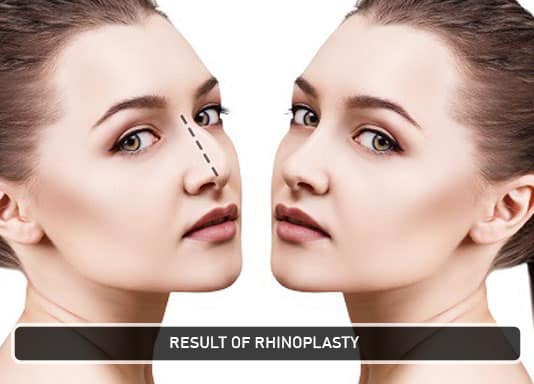
Do you know about: Do I get beautiful face after rhinoplasty?
Rhinoplasty is performed by many doctors in Iran
Of course, rhinoplasty is performed a lot in Iran and a large number of people in Iran perform this operation every year to achieve the desired result. This surgery, as mentioned, has many benefits as well as its own risks
But unfortunately, these days, sometimes this operation is not used to eliminate defects, and these days in Iran, it is mostly because of fashion and simply because a large number of people have performed this operation and maybe their nose has no problem.
They are impressed and do so to enter this fashion trend. Some people do this because they want to show their financial strength and use some kind of work to express their financial strength and well-being. Unfortunately, sometimes even people who do not have enough capital to do this, just imitate others, ask the banks for heavy loans to do so.
But if you want to use this operation just because you see a defect in your nose, be sure to note that sometimes a very small number of nose surgeries are performed without permission and by non-specialists. To have a specialist doctor, you must check his work and education.

More about: Best rhinoplasty surgeon in Iran
As you know, cosmetic surgeons are physicians who have specialized in the field of cosmetic surgery to help patients in the field of elimination of birth defects or defects that have been created for various reasons.
Every year, a large number of surgeons and cosmetic surgeons graduate from prestigious colleges in Iran, and there is up-to-date and modern equipment in Iranian hospitals so that doctors can perform the best surgery.
In cosmetic surgeries, especially rhinoplasty surgery, Iran has grown significantly and has gained a lot of skills in this field.
Due to the existence of the Internet, people in other countries quickly realized Iran’s reputation for rhinoplasty, and every year a large number of people from other countries want to have this operation in Iran.
Iran performs 7 times more rhinoplasty every year than the United States, and this in itself can show the professionalism of Iranian surgeons.
The total cost of performing this operation in Iran is lower than other countries and performing this operation in Iran will be more cost-effective.
Rhinoplasty, which is one of the most popular plastic surgeries among all classes and all ages, often has very lasting and good results in the field of beauty and health. Improving breathing is one of these results, especially when this plastic surgery is used to correct a deviated septum or problems such as snoring. However, there are rare cases in which this plastic surgery itself leads to respiratory problems.
What causes respiratory problems after rhinoplasty?
As mentioned earlier, rhinoplasty in Iran is used to treat many respiratory problems. Experts also say that newer techniques for reshaping the nose will not cause some breathing problems. However, the following four categories of problems may occur in very few cases. These items are:
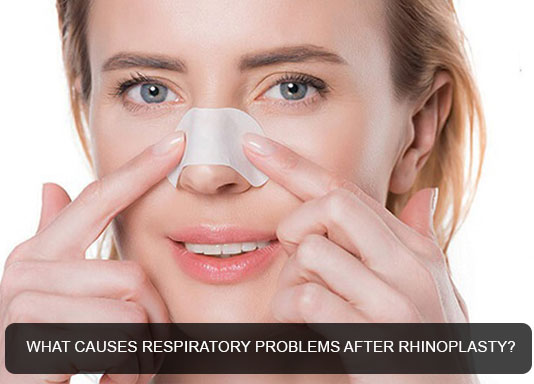
1.Temporary respiratory problems
Due to the swelling of the fiber and the internal structure the nose, nasal breathing usually becomes temporarily difficult following rhinoplasty. Fortunately, newer techniques have emerged in rhinoplasty that prevent the nasal breathing problems to reshape as they did before rhinoplasty. Rhinoplasty has evolved significantly in the last twenty years, and this will lead to fewer complications after rhinoplasty.
2.Excessive shaving of the nasal cartilage
People who underwent rhinoplasty years ago often complain of insomnia and other nasal airway problems. This is probably because the cartilage has been removed too much. In such cases, breathing through the nose can become a long-term problem. Of course, this phenomenon is also rare, and these days, with the advancement of techniques, we see less of it.
3.Shrinking of the respiratory valve
Breathing problems after rhinoplasty in iran usually occur due to the narrowing of the nasal valve to a smaller angle. If this angle becomes smaller after surgery, it can cause significant breathing difficulties. To test whether your nasal valve is causing a problem or not, hold both sides of your nose with two fingers and touch from the tip of the nose upwards, where the cartilaginous area reaches the bony area. This part is called the nasal valve. If you feel the airway open and the breathing improves by pulling on the skin in this area, it is likely that your respiratory valve is getting smaller during the operation and you will need to be examined by a surgeon to find the right solution to this problem.
4.Perforation between the two nostrils
Occasionally there will be respiratory problems if the wall that divides your nose into two parts, gets pierced. Especially when you sneeze, this tissue dries out very easily and bleeds very easily. This has happened a lot before, but these days rhinoplasty has improved and the skill of doctors is exemplary and will prevent this problem. So with a little care and research before surgery, this complication can be prevented.
What are the respiratory problems after rhinoplasty?
In most cases, respiratory problems after rhinoplasty will be temporary and will not be worrying. In general, the following problems can interfere with nasal breathing after surgery:
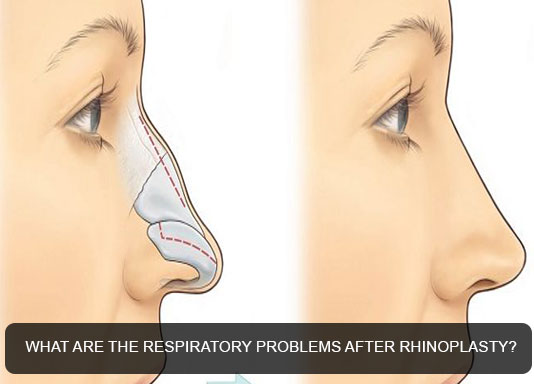
1.Nasal congestion
As you know, the nose becomes swollen after surgery, which occurs both on the outside of the nose and inside the nose. Swelling of the inside of the nose limits the natural space available for normal breathing, which can lead to nasal congestion. If you have chosen a skilled surgeon for the operation, do not worry about this problem because this condition will improve after a maximum of 1 month.
2.Nose whistling
Another respiratory problem after rhinoplasty in Iran is nose whistling while inhaling and exhaling. This complication may be as frightening for people as the previous one. There are several reasons that can lead to nose whistling, the most important of which is the excessive shrinkage of the nostrils. This narrows the respiration airway. Obviously, when the air passes through a narrow area, it makes a whistling sound. Other causes of nose whistling include nasal polyps, allergies, lung or sinus disease, or inflammation.
3.Shortness of breath
Shortness of breath is also seen temporarily in most people who have had rhinoplasty. The cause of this shortness of breath is often the presence of blood clots (as a result of surgery), swelling of the internal tissues of the nose, inflammation of the nasal mucus, or non-professional surgery. All but the last one are usually temporary and will improve after 2 to 3 weeks.
Prevention of respiratory problems after rhinoplasty
Many respiratory problems are preventable after rhinoplasty and can be easily prevented. The best and most important things to consider in this regard include the following:

1.Choose a skilled surgeon
Undoubtedly, a doctor or plastic surgeon who has a lot of successful experience in his resume and, in addition, masters the latest methods in the field of rhinoplasty, will greatly help reduce the complications and problems after this operation.
2.Choosing a reputable beauty center and clinic
The person who has made the decision to have rhinoplasty in Iran must make sure that the medical center is valid, that the equipment is up-to-date, and possesses the necessary permits and standards required for this type of surgery. Note that there is a lot of advertising in this area and some centers are looking to attract people under the pretext of lower costs. It is better not to be deceived by these yellow ads and do not forget that due to the durability of the results, you will pay for the nose surgery once and you will enjoy the results for a long time.
3.Follow care tips
Many people look at nose job only one-dimensionally and ignore the most important aspect which is post-rhinoplasty care. In fact, 50% of the results depend on the surgery, the skill of the doctor and the credibility of the medical center. The rest of the results and the prevention of problems depend on the care process during the recovery period. To prevent problems such as dry nose and the like, it is better to pay attention to rinsing the nose, proper sleep, tips for coughing and sneezing and colds after rhinoplasty. Some respiratory problems appear only in the recovery process due to changes in the structure of the nose after rhinoplasty and will disappear over time as well as with proper care. Also during this period, it is better to avoid manipulating the nose and hitting it to prevent respiratory problems.
4.Need for secondary rhinoplasty after respiratory problems
It is best to consult your surgeon if experience certain problems during rhinoplasty, such as perforation of the wall, abnormal bleeding, and deviation in the septum. In acute cases of respiratory problems, secondary rhinoplasty is needed to repair the cartilage and wall and eliminate the problems. Since secondary rhinoplasty is more difficult than primary nose job, this problem can be easily prevented by carefully choosing a skilled surgeon in the first rhinoplasty. If reoperation is needed, be sure to consult the best rhino surgeon who has the necessary skills in this field and has skill in performing such surgeries.
How long does the respiratory problem last after rhinoplasty?
Respiratory problems after rhinoplasty may last for 3 weeks or more, depending on the type and severity. For example, things like nose whistling, nasal congestion, nose running and poor breathing will go away in 3 weeks to a month (if there is no structural problem in the nose). However, if the nasal structures are damaged during the operation (for example, destruction of nasal cartilage, perforation of the septum or nasal septum, crooked nasal bridge, etc.), the final side effects will remain in the person for life, and unfortunately they will be very annoying.
Thus, it is recommended that if you are worried about respiratory complications after rhinoplasty, be sure to spend a lot of time choosing the best nose job in Iran or restorative surgeon and do not take any risks. Choose surgery that cares about your health and the quality of your breathing in the first place, not just beauty.
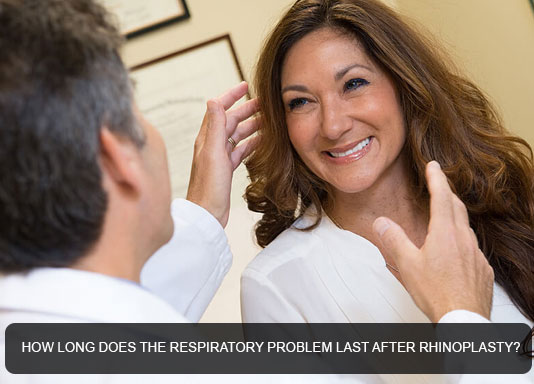
How many days after rhinoplasty can you breathe through your nose?
Breathing after rhinoplasty is a big challenge for people who go for this surgery. It is very important and necessary that after the nose surgery, the person can breathe easily through the nose and inhale and exhale regularly without any problems. Occasionally, some doctors narrow the airways too much to create a slim, fancy nose. In general, nasal breathing becomes easier from one week after surgery. Nasal breathing improves in the following weeks and generally returns to normal 1 to 2 months after surgery. Therefore, people should be able to breathe easily through their noses after this time, and for this, it is essential that you follow carefully and precisely the post-surgery recommendations given by your doctor.
Breathing through the mouth after nasal surgery is essential until your doctor prescribes it. You should also be careful not to sneeze or blow your nose during this time. The reason for these conservatisms is to take care of the stitches and prevent the nose from starting to bleed and the end result of the nose operation to be unfavorable.
How is shortness of breath treated after rhinoplasty?
Whatever the cause of the respiratory problem after rhinoplasty, it should be examined under the supervision of the same surgeon to select and apply the best available treatment for the problems. for example:
If things like allergies have led to shortness of breath, shortness of breath can be treated with allergies treatment (by your doctor for anti-allergy medications).
17 Tips that you should Know About Meaty or Fleshy Rhinoplasty!
Disorders such as nasal polyps and sinus and lung problems can also relieve shortness of breath after treatment.
If the presence of mucus and blood clots causes shortness of breath, the use of washing serums prescribed by the surgeon can quickly solve this problem.
However, it will be different if a person has certain problems during rhinoplasty, such as perforation of the septum (nasal septum), abnormal bleeding, and deviation in the septum. In acute cases, respiratory problems will require secondary rhinoplasty (restorative nasal surgery) to rebuild and repair the cartilage and septum of the nose.

Does rhinoplasty also improve respiratory problems?
With the help of rhinoplasty, respiratory problems that are caused by the problems of external and internal valves of the nose can be eliminated. Of course, this issue should be thoroughly examined by a specialist.
Not only do some people not have breathing problems after rhinoplasty; But by correcting sinus problems, correcting the shape of broken cartilage, they can breathe easier. This is why rhinoplasty is also a treatment for this group of people.
In fact, as long as the person only acts to correct the shape of the nose and beauty for rhinoplasty, he will have an optional surgery. But when this operation is used to solve structural problems of the nose, it is not an option and must be done.
In what cases is respiratory problems normal after rhinoplasty?
It is normal for rhinoplasty to affect the patient’s nose and respiratory airways. As a result, the patient may have nasal congestion for some time and may not be able to breathe well. Bleeding and swelling of the nose aggravate this problem and cause the patient anxiety. Respiratory problems after rhinoplasty caused by nasal congestion are among the natural complications of this surgery. These problems improve after a short time.
The patient should be careful at this time not to take deep breaths with his nose. Also, in case of cough or sneezing, he must direct the air through his mouth.
Your doctor may suggest solutions such as rinsing with saline to prevent nasal congestion and respiratory problems after rhinoplasty. In any case, this problem persists until the initial injuries caused by the surgical invasion are healed, and there is nothing to worry about.
Surgery makes it difficult for the patient to breathe for a while. This does not mean that the patient has a respiratory problem. People who have had surgery can usually breathe through their nose after a week. Their breathing process gradually improves in the following weeks and returns to normal after one to two months. It is interesting to note that many patients report that they can breathe more easily after this period. This is due to the elimination of complications such as polyps and the improvement of their nasal shape.
Related post
Top 5 cheapest countries for rhinoplasty
Top 30 rhinoplasty surgeons In the world
